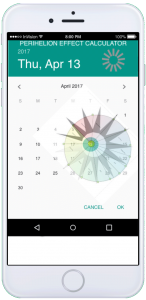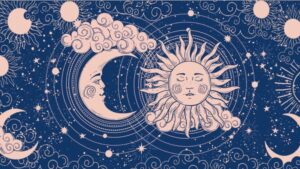http://www.archaeoastronomy.com/seasons.html
http://www.archaeoastronomy.com/countdowns.html
Until 500 years ago most people other than a few far-sighted philosophical scientists imagined the sun, the planets and the stars all revolved around a stationary earth. After all, the same heavenly track made by the sun during the day is the planetary passageway at night. Eventually, the earth was shown by Nicolaus Copernicus to spin on its axis and revolve around the sun. Yet, the apparent orbit of the sun around the earth, the Ecliptic, is the principal model used by astronomers even now to plot the sun’s displacement in the sky. The Ecliptic Plane, Figure 2, is the two-dimensional slice defined by this imaginary solar orbit around the earth. The area shown represents approximately 50 quadrillion square miles. As with earth’s actual orbit of the sun, the Ecliptic is not quite circular. It is an ellipse whose major axis is the red line. Aphelion is furthest separation. Perihelion is nearest approach. The radius is 150 million kilometers ±1.7%. The sun revolves counter-clockwise in this view. The beauty of visualizing with the Ecliptic is that Equinox solar positions are at precise right angles to Solstice solar positions. And the Cross Quarter moments exactly bisect these, forming perfect 90° angles with neighboring CQ’s. Only at Equinox moment is the sun on the earth’s Celestial Equatorial Plane, another two-dimensional slice extending into space, defined by the earth’s Equator. The Ecliptic Plane intersects this Equatorial Plane along the blue line in Figure 2, with their angle of intersection matching the 23°26′ polar tilt. By astronomical convention the 0° point on the Ecliptic is occupied by the sun at Vernal Equinox.
According to Johannes Kepler’s Second Law, any line between the earth and the sun sweeps out equal areas in equal time. Even in a slightly elliptical circuit, orbital velocity accelerates from Aphelion to Perihelionand decelerates from Perihelion to Aphelion. Thus, the sweep intervals along each 45° arc must be unequal due to unequal areas within each pie slice, offset as they are to the apparent orbit’s major axis stretching from the bulge near 102° to the flats near 282°. Table 1 displays the approximate time intervals in recent years along the eight 45° arcs.
|
“Solstices, equinoxes and seasonal midways called cross quarters were vital to ancient people for regulating their calendars and knowing when to plant, when to harvest, when to stay, when to move. From the earth on the ecliptic plane, the sun appears to cycle each year past the same, twinkling stars of the Zodiac. Equinoxes and solstices are separated by precise 90 degree angles according to astronomical convention. The cross quarters exactly bisect these and served as Celtic boundaries for each of the four seasons. The Celts named the cross quarters Beltaine, Lughnasad, Samain and Imbolc. Displayed below these names are the modern calendar dates that match them astronomically.” 1.3 MB ©MMV TransVision |
![]() Figure 3. Animation of changing sunrise locations up to 5 days before and after Equinoxes and Solstices in Northern Hemisphere
Figure 3. Animation of changing sunrise locations up to 5 days before and after Equinoxes and Solstices in Northern Hemisphere
(for Northern Hemisphere sunsets, flip all labels horizontally; for Southern Hemisphere sunrises,
swap Equinox labels and swap Solstice labels; for Southern Hemisphere sunsets, reverse North and South labels only)
Figure 3 diagrams the offset of sunrise and sunset positions at the horizon — approximately equal to one solar diameter each day — near the Equinoxes, the greatest day-to-day movement at any time of the year. Ancient skywatchers almost certainly were aware of this. Near the Solstices sunrise and sunset positions at the horizon are approaching and receding from their annual extremes, reversing direction at some point within a virtual standstill of about a week’s duration. Solstices occur when the sun appears directly overhead at either of its most extreme latitudes — 23°26’N or 23°26’S — of the year. At Solstice the semi-annual northbound or southbound apparent journey of the sun turns around. It is practically impossible to determine exactly when a Solstice occurs based only on shadowplays cast by the rising or setting sun within the standstill week. With an intuitive grasp of the sun’s movement along the Ecliptic, and given a choice, ancient timekeepers would have found that memorializing either Equinox in stone, versus construction of a Solstice alignment, left posterity a superior tool to accurately clock the year.
Seasonal Cusps as Pagan and Religious Holidays
In common parlance Equinoxes are when day and night are equal in length and the sun rises due east and sets due west, assuming unobstructed and flat horizons. At the precise moment of Equinox, the sun crosses the earth’s Celestial Equatorial Plane. Religions likely discovered that by acknowledging and even honoring ancient and mythic sun ceremonies, non-believers could more readily be brought into the fold. Clerics termed the Vernal Equinox Eostar and the Autumnal Equinox Mabon to salute, perhaps even to sanctify, these special days of pagan worship. Likewise, the Church named Summer Solstice Litha and the Winter Solstice Yule. Here is a hint if you have ever wondered why Christmas and Easter have uncanny calendric correspondencies to the Winter Solstice and the Vernal Equinox. The supernova that may have been the Star of Bethlehem is not fixed historically on any specific date. Before Jesus was born, the Winter Solstice carried powerful mythic weight.
Watch our 3 minute video podcast on the Winter Solstice’s connection to Yule at the ![]() Store
Store
The Vernal Equinox, around Easter, holds special magic, ushering in the return of warmth, and with it, the renewal of plant and animal life. Coincidentally, Christianity marks this time as the anniversary of the Resurrection.
Old Celtic calendars observed Cross Quarters, approximately midway between each pair of adjacent Equinox and Solstice days. Unlike modern calendars that define the start of a season on a Solstice or Equinox, the Celts perceived Solstices and Equinoxes as events occuring mid-season, with the seasons actually beginning and ending on the Cross Quarters.
Thus, Imbolc was the beginning of Spring. Imbolc corresponds more or less to Groundhog Day in the USA, February 2, when tradition has it that if a sleepy groundhog creeping out of its burrow at dawn sees its shadow, there are 6 more weeks of winter. (If not, we surmise, only 42 days remain.) Solmonath and Candlemas were Church-approved substitute names for Imbolc, which is spelled Imbolg by some pagans. Druids prefer Oimeaig, pronounced IM-mol’g.
Beltaine was the start of Summer, just a few days beyond May Day on the modern calendar. Fertility is at its peak as bees pollinate the flowers. Seedlings are poking through the cool soil, seeking the warmth and energy of the sun. Early Christians preferred the name Whitsuntide instead of Beltaine. The pronunciation of this cross quarter is BEE-awl-ten-ah
Lughnasad was the beginning of Autumn, when crops thrive in the hot sun. Lughnasad was observed as a pre-harvest festival day and time for strength and endurance competitions among young men. Variations on this CQ name include Lughnasadh, Lughnasada and Lugnasadh. It is pronounced LOO-na-sah regardless of the spelling. The religious equivalent is Lammas or Lammos.
The Celtic Winter began with Samhain. It ends one planting cycle and begins another. Seeds for the next year were often planted at this time. Samhain comes about a week after Hallowe’en, the eve of All Saints Day when, some folks believe, all departed souls of the preceding year are finally freed from earthly ties. Indeed, the Christian name Hallowmas was swapped for the pagan term, sometimes spelled as Savain. Regardless of the spelling, this CQ day is pronounced SOW-an or SOW-in.
Listen to our 3 minute podcast on Samhain and the Celtic New Year at the ![]() Store
Store
Perhaps the Celtic perception of the seasonal calendar harmonizes best with nature. Should Summer’s arrival really mark a time of year when daytime just gets shorter and shorter? Is it logical for days to only lengthen throughout Winter? It seems to contradict our perception of what these seasons are, or is it just a mid-Summer’s night dream of mine? The Celts believed major transitional days — Solstices and Equinoxes — should be enveloped by the time of year they signify, not stand for mere boundary markers! Celtic calendar keepers favored the Cross Quarters as bookends for every season under the sun.



